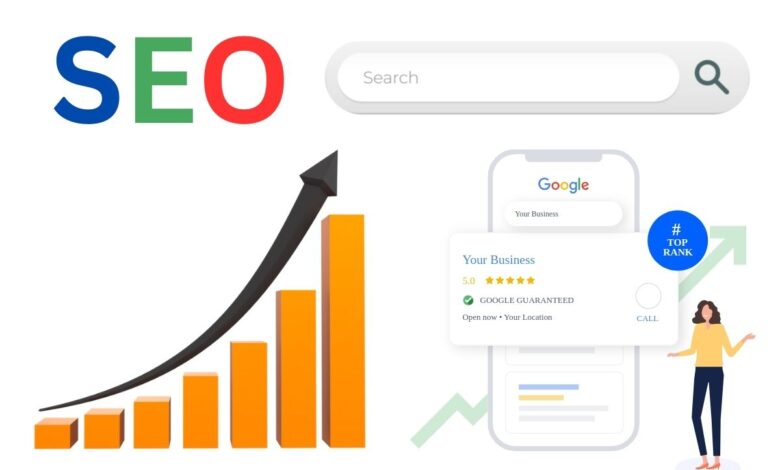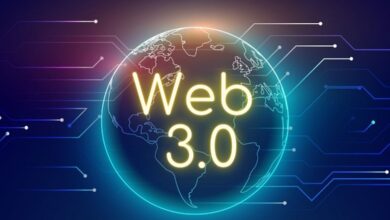Search Engine Optimization: A Comprehensive Guide to Enhancing Your Website’s Visibility in 2024

In today’s digital landscape, businesses face a constant challenge: how to stand out from the crowd and attract potential customers. Amidst the vast sea of websites vying for attention, Search Engine Optimization (SEO) emerges as a beacon of hope. SEO is the art and science of optimizing your website to rank higher in search engine results pages (SERPs), ultimately leading to increased organic traffic and a wider audience. If you’re looking to boost your online presence and drive business growth, understanding and implementing SEO strategies is crucial.
Table of Contents
1- Introduction to Search Engine Optimization (SEO)
1.1 What is SEO?
The process of raising a website’s position in search engine results is known as SEO. It involves a series of techniques that make your website more visible and relevant to search queries, thereby increasing the likelihood of users finding your content.
1.2 Why is SEO important?
SEO is crucial for businesses because it helps them achieve their online goals, such as:
Increased website traffic: By ranking higher in SERPs, your website attracts more organic visitors, expanding your reach and potential customer base.
Enhanced brand reputation: A well-optimized website signals authority and trust, fostering a positive brand image and credibility.
Improved return on investment (ROI): SEO is a cost-effective marketing strategy compared to traditional advertising, offering a higher ROI over time.
1.3 Benefits of SEO
SEO offers numerous benefits that extend beyond increased website traffic. These include:
Generate leads and sales: Attract potential customers actively searching for products or services like yours.
Establish authority and expertise: Position your website as a trusted source of information in your industry.
Enhance user experience: Optimize your website for user convenience, increasing engagement and satisfaction.
Gain competitive advantage: Outperform competitors in search results, capturing a larger share of online traffic.
2- Understanding Search Engine Algorithms
2.1 How search engines work
Search engines are complex systems that use a variety of algorithms to crawl, index, and rank websites. The crawling process involves sending out bots or spiders to discover new websites and pages. Once a website is discovered, it is indexed, which means that it is stored in a database for future reference. When a user performs a search, the search engine retrieves the most relevant pages from its index and ranks them based on a variety of factors.
2.2 Ranking factors and algorithms
The exact algorithms used by search engines are proprietary, but there are a number of known factors that influence ranking. These include:
- Relevance: The content of a website should be relevant to the search query.
- Authority: Websites that have a high level of authority, as measured by backlinks from other high-quality websites, are likely to rank higher.
- Technical factors: Websites that are technically sound and easy for search engines to crawl and index are likely to rank higher.
- User behavior: Search engines also take into account user behavior, such as click-through rates and time spent on page, when ranking websites.
2.3 Search intent and user behavior
Search intent is the reason why a user is performing a search. Search engines try to understand the intent of a search in order to provide the most relevant results. For example, if a user searches for “best laptops,” the search engine will try to return websites that compare and review different laptops.
Understanding user behavior is also important for SEO. Search engines track how users interact with websites, such as how long they spend on a page and how often they click on links. This data can be used to improve the ranking of websites that provide a good user experience.
Additional considerations
In addition to the factors mentioned above, search engines also consider a number of other factors when ranking websites, such as:
Freshness: Websites that are regularly updated with new content are likely to rank higher.
Location: Search engines can also take into account the location of the user when ranking websites.
Mobile-friendliness: Websites that are designed to be mobile-friendly are likely to rank higher for mobile searches.
3- On-Page SEO Optimization Techniques
In the competitive realm of online visibility, search engine optimization (SEO) stands as a crucial tool for businesses and individuals alike. On-page SEO, the practice of optimizing web page content for search engines, plays a pivotal role in enhancing a website’s ranking and attracting organic traffic. By implementing effective on-page SEO techniques, you can transform your website into a magnet for relevant searches, leading to increased brand awareness, enhanced user engagement, and ultimately, business growth.
3.1 Keyword research and optimization
The foundation of successful on-page SEO lies in identifying and strategically incorporating relevant keywords throughout your website’s content. Keyword research involves delving into the search terms that your target audience uses to find information related to your products, services, or expertise. By understanding these search patterns, you can craft content that seamlessly integrates these keywords, signaling to search engines the relevance of your web pages to specific search queries.

3.2 Content creation and optimization
Content is the heart of any website, serving as the substance that engages visitors and conveys your brand’s message. In the context of on-page SEO, content optimization involves crafting high-quality, informative, and engaging content that not only appeals to your target audience but also adheres to search engine guidelines. This entails incorporating relevant keywords naturally into the content, ensuring readability and structure, and utilizing multimedia elements to enhance user experience.
3.3 Title tags, meta descriptions, and header tags
These three elements, often referred to as the “SEO trinity,” play a critical role in capturing the attention of search engines and users alike. Title tags provide a concise summary of the page’s content, while meta descriptions offer a brief overview of what visitors can expect. Header tags, such as H1, H2, and H3, organize the page’s content into a clear hierarchy, aiding both search engines and users in understanding the page’s structure and key points.
3.4 URL structure and internal linking
A well-structured URL provides a clear path for search engines to navigate your website, ensuring that your content is properly indexed and discoverable. Internal linking, the practice of creating hyperlinks between relevant pages within your website, serves two purposes: it enhances user experience by guiding visitors through related content, and it signals to search engines the importance of specific pages, influencing their ranking.
3.5 Image optimization and alt text
Images are powerful tools for enhancing visual appeal and conveying information, but they also play a role in on-page SEO. Optimizing images involves using relevant file names, compressing them for faster loading times, and incorporating alt text, which provides descriptive text alternatives for images. Not only does alt text increase accessibility for visitors with visual impairments, it also aids search engines in deciphering the information of your photographs.
4- Technical SEO Optimization Techniques
While on-page SEO focuses on optimizing the content of your website, technical SEO delves into the underlying infrastructure and architecture of your site. By addressing technical aspects, you can ensure that your website is search engine-friendly, enabling search engines to crawl, index, and understand your content effectively.
4.1 Website crawling and indexing
Search engines rely on crawlers, automated programs that scan the internet to discover and index websites. To ensure that your website is crawlable and indexable, it’s crucial to have a robots.txt file in place, which instructs crawlers which pages to index and which to avoid. Additionally, creating a sitemap, a file that lists all the URLs on your website, helps search engines discover your content more efficiently.
4.2 Website speed and performance
Speed of a website is important for search engine ranking and user experience. Slow-loading pages can lead to increased bounce rates and decreased user engagement, negatively impacting your SEO performance. Optimizing website speed involves factors such as optimizing images, minifying code, and utilizing caching mechanisms to deliver content faster.

4.3 Mobile-friendliness and responsiveness
With the increasing prevalence of mobile internet usage, ensuring a mobile-friendly website is paramount. Google’s mobile-first indexing approach prioritizes websites that provide a seamless user experience on mobile devices. Responsive design, which adapts the website’s layout to different screen sizes, is essential for mobile-friendliness.
4.4 Structured data and markup
Schema markup, another name for structured data, is a means to give search engines more details about the content of your website. By embedding structured data into your HTML code, you can help search engines understand the context and meaning of your content, leading to richer search results and potentially improved rankings.
4.5 Error handling and redirects
Broken links and error pages can hinder search engine crawling and negatively impact user experience. Regularly checking for and fixing broken links and implementing proper redirects for outdated or moved URLs are essential for maintaining a healthy technical SEO foundation.
5- Off-Page SEO Optimization Techniques
Off-page SEO, unlike on-page SEO, focuses on factors outside of your website that can influence its ranking in search engine results pages (SERPs). These factors include backlinks, social media engagement, brand mentions, and other signals that indicate the authority and trustworthiness of your website.
5.1 Link building and backlink acquisition
The practice of getting links to your website from other websites is known as link building. Backlinks are considered a strong signal of authority and trust, as they indicate that other websites consider your content to be valuable and relevant. There are various strategies for link building, such as guest blogging, creating high-quality content that attracts natural links, and participating in online communities and forums.
5.2 Social media marketing and engagement
Social media plays a significant role in off-page SEO. Actively promoting your website and content on social media can increase brand awareness, drive traffic to your website, and generate backlinks. Engaging with your audience on social media builds trust and credibility, further enhancing your off-page SEO efforts.
5.3 Influencer marketing and brand partnerships
Collaborating with influencers in your industry can significantly boost your off-page SEO efforts. Influencers have established audiences and credibility, and their endorsement of your brand can lead to increased brand awareness, social shares, and backlinks. Strategic brand partnerships can also expand your reach and enhance your authority.
5.4 Online reputation management and reviews
Maintaining a positive online reputation is crucial for off-page SEO. Positive reviews and testimonials from satisfied customers can boost your credibility and trust signals, influencing search engine rankings. Actively managing online reviews and responding to customer feedback demonstrates your commitment to providing excellent customer service.
5.5 Local SEO and business listings
If your business has a physical location, local SEO is essential for attracting local customers and improving your visibility in local search results. Optimizing your Google My Business listing, claiming citations on relevant local directories, and building relationships with local businesses can significantly impact your local SEO performance.

By implementing these off-page SEO techniques, you can enhance your website’s authority, attract more visitors, and improve your overall search engine ranking. Remember, off-page SEO is an ongoing process that requires consistent effort and strategic planning.
6- SEO Measurement and Analytics
Effective SEO is not just about implementing strategies; it’s also about measuring and analyzing the results of those strategies. This is where SEO measurement and analytics come into play. By tracking key metrics and analyzing data, you can gain valuable insights into how your SEO efforts are performing, identify areas for improvement, and make data-driven decisions to optimize your website for search engines.
6.1 Tracking website traffic and user behavior
Understanding how visitors are finding and interacting with your website is crucial for optimizing your SEO strategy. Tracking website traffic metrics such as organic traffic, referral traffic, and bounce rate can provide insights into which channels are driving traffic to your site and how long visitors are staying engaged. User behavior analytics, such as heatmaps and session recordings, can reveal how users navigate your website, identify areas of confusion or friction, and suggest improvements to enhance user experience and conversion rates.
6.2 Monitoring keyword rankings and search visibility
Keyword rankings, which indicate the position of your website in search results for specific keywords, are a vital metric for assessing your SEO performance. Monitoring keyword rankings over time can help you identify trends, measure the impact of your SEO efforts, and determine which keywords are driving the most relevant traffic to your site. Search visibility, which measures the overall impression of your website across multiple keywords, provides a broader view of your organic search performance.
6.3 Analyzing website conversions and goals
SEO is ultimately about driving conversions, whether it’s generating leads, making sales, or achieving other specific goals. Analyzing website conversions involves tracking key metrics such as conversion rate, cost per acquisition (CPA), and customer lifetime value (CLV). By understanding which pages and keywords are generating conversions, you can optimize your SEO strategy to focus on the most profitable areas of your business.
6.4 Using SEO tools and analytics platforms
A variety of SEO tools and analytics platforms can help you track, analyze, and report on your SEO performance. These tools provide data visualizations, dashboards, and reporting capabilities that make it easy to understand your website’s SEO health and identify areas for improvement. Google Analytics, Google Search Console, SEMrush, Ahrefs, and Moz are a few of the well-known SEO tools.
6.5 Making data-driven decisions and improvements
SEO is an iterative process that requires continuous monitoring, analysis, and adjustment. By regularly reviewing your SEO data, you can identify areas where your strategy is working well and areas that need improvement. Make data-driven decisions to optimize your content, website structure, and backlink profile, and continuously refine your SEO strategy to achieve your long-term goals. Remember, SEO is a marathon, not a sprint, and consistent effort will lead to sustainable growth and success.
7- Common SEO Mistakes and Pitfalls
7.1 Keyword stuffing and excessive optimization
Keyword stuffing is the practice of forcing too many keywords into your content in an unnatural way. This can negatively impact your search rankings, as search engines are becoming increasingly sophisticated at identifying and penalizing keyword stuffing. Rather, concentrate on producing helpful, high-quality content that organically includes pertinent keywords.
7.2 Duplicate content and plagiarism issues
Duplicate content occurs when the same content appears on multiple websites. This can be a result of copying and pasting content from other sources or having multiple pages on your own website that contain the same content. Search engines penalize duplicate content because it can make it difficult for them to determine which version of the content is the original and authoritative source.
7.3 Low-quality backlinks and link schemes
Backlinks are links from other websites to your website. They are considered a strong signal of authority and trust, as they indicate that other websites consider your content to be valuable and relevant. However, not all backlinks are created equal. Low-quality backlinks from spammy or irrelevant websites can harm your search engine reputation. Avoid participating in link schemes, which are artificial attempts to increase the number of backlinks to a website.
7.4 Ignoring mobile optimization and user experience
Mobile optimization is the process of making your website look and function well on mobile devices. With the increasing prevalence of mobile internet usage, it is more important than ever to ensure that your website is mobile-friendly. Ignoring mobile optimization can alienate a significant portion of your audience and negatively impact your search rankings.
7.5 Neglecting technical SEO and website structure
The architecture and underlying framework of your website are referred to as technical SEO. It includes factors such as website speed, error handling, and URL structure. Technical SEO issues can hinder search engines from properly crawling and indexing your website, which can negatively impact your search rankings.
Here are some additional tips to avoid common SEO mistakes:
- Do your keyword research. Before you start writing content, take some time to research the keywords that are relevant to your business or niche. This will help you to identify the keywords that people are using to search for information online and to create content that is targeted to those keywords.
- Create high-quality content. The most important factor in SEO is the quality of your content. Search engines favor websites that provide high-quality, informative content that is relevant to the needs of their users.
- Build backlinks from high-quality websites. Backlinks are still a very important factor in SEO. However, it is important to build backlinks from high-quality websites that are relevant to your niche.
- Optimize your website for mobile devices. Make sure your website is easy to use and navigate on mobile devices. This includes using a responsive design that adapts to different screen sizes and using large fonts and easy-to-tap buttons.
- Submit your website to search engines. Make sure your website is submitted to the major search engines, such as Google and Bing. This will help them to discover your website and start indexing your content.
By avoiding these common SEO mistakes and following these tips, you can improve your website’s SEO and attract more organic traffic.
8- SEO Trends and Future Considerations
8.1 Voice search and natural language processing
Voice search is becoming increasingly popular, as people are using voice assistants like Amazon Alexa and Google Home to search for information online. This trend is driving the need for websites to be optimized for voice search. The area of computer science known as natural language processing (NLP) studies how computers and human (natural) languages interact. NLP is being used to develop voice search algorithms that can better understand the nuances of human language.

8.2 Artificial intelligence & machine learning
AI and ML are being used to develop more sophisticated search engine algorithms that can better understand the intent of search queries and deliver more relevant results. For example, AI can be used to identify the context of a search query, such as the user’s location or search history. This information can then be used to personalize search results.
8.3 Video optimization and content marketing
Video is becoming increasingly popular as a form of content, and search engines are taking this trend into account. Websites that optimize their videos for search engines are more likely to rank higher in search results. This includes factors such as using relevant keywords in video titles and descriptions, and transcribing video content into text.
8.4 User privacy and data protection regulations
User privacy and data protection are becoming increasingly important concerns, and search engines are taking this into account. Websites that collect and use user data must do so in a way that complies with applicable data protection regulations. For example, websites must obtain user consent before collecting cookies, and they must provide clear information about how user data is being collected and used.
8.5 Evolving search engine algorithms and ranking factors
Search engine algorithms are constantly evolving, and the factors that influence search rankings are constantly changing. Websites that want to stay ahead of the curve need to keep up with the latest SEO trends and best practices.
Here are some additional tips for staying ahead of the curve in SEO:
- Monitor industry trends and news. Keep up with the latest SEO news and trends by reading industry blogs and publications.
- Attend SEO conferences and events. Attending SEO conferences and events is a great way to learn about the latest SEO trends and techniques.
- Network with other SEO professionals. Networking with other SEO professionals can help you to stay up-to-date on the latest trends and best practices.
- Join SEO communities and forums. There are many online SEO communities and forums where you can learn from other SEO professionals and ask questions.
FAQs about Search Engine Optimization
What is the difference between SEO and SEM?
SEO (search engine optimization) and SEM (search engine marketing) are both strategies for improving a website’s visibility in search engine results pages (SERPs). However, they differ in their approach.
SEO is focused on improving a website’s organic ranking in SERPs. This means making changes to the website itself, such as improving the quality of the content, optimizing the website for keywords, and building backlinks from other websites.
SEM is focused on improving a website’s visibility in SERPs through paid advertising. This means paying for ads that appear at the top of SERPs or on the side of search results pages.
In short, SEO is about earning traffic, while SEM is about buying traffic.

How long does it take to see results from SEO?
It can take several months or even longer to see results from SEO. This is because SEO is a long-term process that requires consistent effort. However, once SEO efforts start to pay off, the results can be very rewarding.
How much does SEO cost?
The cost of SEO can vary depending on a number of factors, such as the size and complexity of the website, the competition in the target market, and the experience of the SEO professional or agency. However, in general, SEO is a cost-effective way to improve a website’s visibility in SERPs.
Can I do SEO myself, or should I hire a professional?
If you have the time and expertise, you can do SEO yourself. However, if you are not familiar with SEO, it is usually best to hire a professional. A professional SEO can help you to develop an effective SEO strategy and implement it effectively.
What are the most important SEO tools and resources?
There are many SEO tools and resources available, but some of the most important ones include:
- Google Search Console: This is a free service that gives you information about how well your website is doing in search engine results.
- Google Analytics: This free tool from Google tracks website traffic and user behavior.
- Ahrefs: This paid tool provides data on backlinks, keyword rankings, and organic traffic.
- SEMrush: This paid tool provides data on keyword rankings, backlinks, and organic traffic.
- Moz: This paid tool provides data on backlinks, keyword rankings, and organic traffic.
Conclusion:
Summary of key SEO principles
SEO is a complex and ever-evolving field, but there are some key principles that remain constant. These principles include:
- Producing useful, top-notch content that appeals to your target market.
- Optimizing your website for the search terms that members of your target audience use.
- Building backlinks from high-quality websites.
- Making sure your website is mobile-friendly.
- Monitoring your SEO performance and making adjustments as needed.
Importance of continuous learning and adaptation
The SEO landscape is constantly changing, so it is important to stay up-to-date on the latest trends and best practices. This means reading industry blogs and publications, attending SEO conferences and events, networking with other SEO professionals, and joining SEO communities and forums.
The future of SEO and its impact on business success
SEO is becoming increasingly important for businesses of all sizes. As more and more people search for information online, businesses that are not visible in search results are missing out on potential customers. SEO is a powerful tool that can help businesses to reach a wider audience and achieve their business goals.
In the future, SEO will become even more important as search engines become more sophisticated and user behavior changes. Businesses that are able to adapt to these changes will be well-positioned for success in the years to come.




